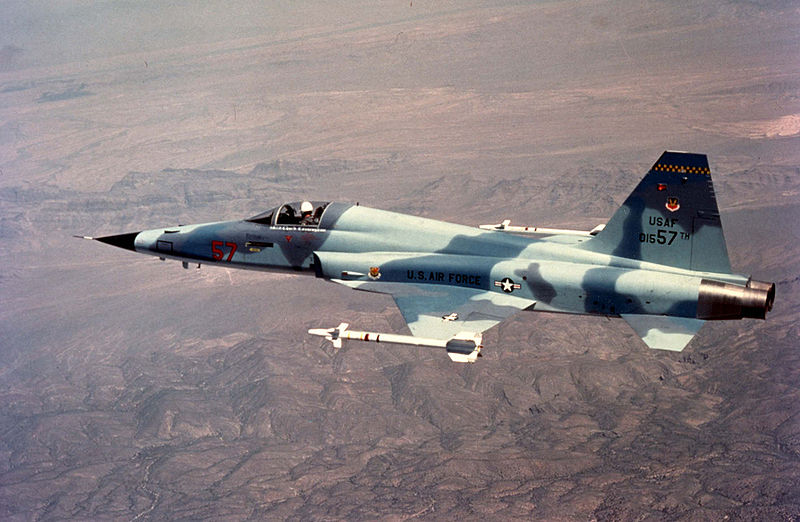What happens to military aircraft when they’re retired? Some go to the scrap heap. Others become exhibits in museums. Some become civic monuments. But a few – a very few – may be put up on the open market. And if you have a spare quarter of a million dollars or more, you could purchase one.
You may be enticed by the Canadair CL-13, the ‘Sabre,’ a Royal Canadian Air Force jet fighter. Built by Canadair under license from North American Aviation, it could carry 2 tons of missiles and bombs and could fly at 710 mph. Production was discontinued in 1958, and it was replaced by the Canadair CF-104 in 1962.
Then there’s the Canadair CF-5, designed for air forces with limited resources and technical support. It was initially deployed for NATO, but it soon became a light attack strike fighter, reconnaissance platform and trainer.
Canada, which sustained a sophisticated aerospace industry, considered the CF-5 an inferior aircraft, thought it had been intended for tactical support for their own forces. It was considerably faster than the CL-13 however, at 1146 mph. There aren’t many Canadairs of either design left. And they’re only around million dollars each.
But perhaps your tastes tend toward something like the Mikoyan MIG-21, which is common. The former Soviet Union and China produced as many as 13000 of these jet fighters. The Mikoyan has seen more action in combat than any other aircraft. It can fly at 1351 mph. The Mikoyan MIG-17, its slighter poorer cousin, achieves on 711 mph. It fought over Vietnam until superseded by faster craft.
Either of these can be yours for a mere $250000. But if you really have too much money, you can purchase the MIG-29 for five million. This Soviet design entered into service in 1983. It was the Soviet answer to the Us McDonnell Douglas F-15 Eagle and General Dynamics F-16 Fighting Falcon. It flies at 1500 mph.
Then there’s the Grumman OV-1 Mohawk. The Mohawk was a surveillance and attack aircraft, with twin turboprops, designed to operate from small, rough airfields.
With its speed, firepower, and armor, it proved a considerable improvement on the Bird Dog, which was proved vulnerable during the Korean War. Its top speed is 305 mph. The price tag? $250000 – $500000.
The Hawker Siddeley Harrier, also known as the Harrier Jump Jet was the first generation of the Harrier series. In the 1960s it was developed as a support and reconnaissance fighter and was the first to employ a vertical takeoff and landing. The Royal Air Force built GR. 1 and GR. Three variants in the late 60s. The United States Marine Corps adopted the Siddeley as the AV-8A in the 1970s. Its top speed is 730 mph. This one can be bought for $250000.
The P-51 Mustang is much more expensive – up to four million dollars – but it is quite literally the Rolls Royce of fighter- bombers. It has a Rolls Royce Merlin engine, though it was originally designed for the Allison V-1710. It can reach altitudes of 15000 feet, and a speed of 450 mph was easily the match of the Luftwaffe’s fighters. It was armed with six .50 caliber M2 Browning machine guns.
You might wish to consider the Lockheed T-33, known as I-Bird. This aircraft was developed by extending the fuselage of the Lockheed P-80/F-80 by three feet and by adding a second seat. The T-33 first took to the air in 1944. It was designed for training pilots. It can fly at 600 mph. It costs $500000.
If you fancy the real classics, then you might be interested in the Supermarine Spitfire. The Spitfire was a single-seat fighter and was of course widely used by the Royal Air Force and other Allied air forces both during and after World War II. Indeed it was the most produced British aircraft. It could fly at 400 mph. There were a number of variants. It is popular with enthusiasts. Only 53 remain in an airworthy condition, many in museums, and you can have one for a mere 4 million dollars or so.
The Saab 35 Draken was a Swedish supersonic fighter, built between 1955 and 1974. It replaced the J29 Tunnan and 32 Lansen. Such was its success that it was exported to Denmark, Finland, Austria and the United States. It could reach 1340 mph and costs $425 000.
The Northrop F-5 or Freedom Fighter was designed in the 1950s by Northrop as a supersonic light fighter but was also capable of ground attack. It was produced as a simpler, smaller and cheaper alternative to the McDonnell Douglas F-4 Phantom II. It has two General Electric J85 engines and can reach a top speed of 1077 mph. At first, its manufacture was privately funded. It entered service in the 1960s. Price – $1.6 million.
If you’re into lightweights, you may prefer to buy a Douglas A-4 Skyhawk. Weighing a mere $24,500 pounds and flying at low altitudes at more than 600 mph, the Skyhawk carried a variety of bombs, missiles, and even nuclear weapons.
It saw service in Vietnam, the Yom Kippur War, and the Falklands. Originally it was powered by a Wright J65 Turbojet engine, but later replaced by the Pratt & Whitney J52. Three thousand remain in service and is used by some air forces. The Skyhawk is a bargain at $3 million.
However, if you’re after classic charm, the B-25 Mitchell Bomber may be the aircraft for you. Named after Major General William ‘Billy’ Mitchell, this US plane served in every theater of World War II. It remained in service for four decades after the war. There are many variants. Ten thousand B-25s were produced in NAA factories. It can reach a speed of 272 mph and costs $70000.
